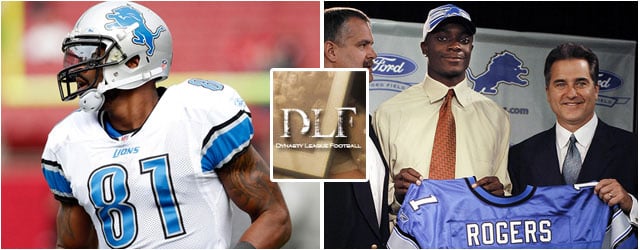Inside the Numbers: Draft History – WRs

Every year, I like to take a look back at draft history as it relates to specific positions. Through this exercise, I’m able to better assess risk when it comes to draft day decisions. Through the years, I always start with the WR position because history has shown no greater risk when it comes to using a high draft position in this area.
It seems that every year during my draft analysis articles, I’m regularly called out for not ranking rookie WRs higher and suggesting that high picks not be used on the position unless there is an extreme talent available or you are in a state of extreme desperation. The fact remains that receivers are just too risky in general to risk a very high pick on. But that is not to say that there aren’t situations or players that that can pay off handsomely should the stars align. And more than any other position, gems can be found beyond round two. One of my strengths has always been locating those difference-making WRs beyond pick 25; after this pick is where things get fun and your due diligence can really pay off.
It’s true that I have a relatively complex rating system that takes into account many factors, weightings and scores towards the goal of ending up with a final score that ultimately ranks each receiver on my list. But like Colonel Sanders, I’m not about to give up my secret recipe. But I am here to help assist you cut through the noise towards ranking this year’s crop of receivers. As we move closer to the draft, I’ll be focusing on this group much closer. Until then, let’s jump into my annual review of the past ten years of draft history as it relates to WRs. Staying true to my normal process, I will not be including last year’s (2010) receivers in the analysis because one year of production is not sufficient to properly label or categorize a player. You could argue that two year’s of experience are not much better but for consistency, I’m sticking with this methodology.
Let me start by giving props to the 2009 receiving group. 5 of 6 (Crabtree, Maclin, Harvin, Nicks and Britt) 2009 first round receivers have become viable fantasy producers. This makes the first round of 2009 the best year, hands down, of any first round in the prior 10 years.
As a refresher, I only analyze the first round and use four categories for the players: Stud, Starter, Bench and Bust. Understand that there is no hard-fast rule for what defines a player in one of the four categories. A “Stud” player is one that should or should have been started every week, regardless of match-up. A “Starter” is a player that would be started in about 75% of situations and was a stable producer during his time. A “Bench” player is a player that would not have been started unless as a last resort and a “Bust” player is one that is or has been just that, a bust. Not everyone will/may share my views as to which category a player exists. As for only analyzing the first round, the reason for this is because 2nd+ receivers will rarely, if ever, grace the first round of a 10 team league draft. What we are assessing here is the likelihood of your first round selection of a NFL first round receiver paying off.
Let’s get to the analysis.
In the years from 2000-2009, there have been 43 WRs taken in the first round. Note that in 2008, no WRs were taken in the first round. Given my current category assessments, these 43 receivers are broken down as follows:
Stud: 6/43 or 14%
Starter: 9/43 or 21%
Bench: 6/43 or 13.9%
Bust: 22/43 or 51.1%
Just because I know many of you will want to know, I’ll tell you who I have in each of the Stud and Starter categories. Listed after his name is the pick at which he was selected in the first round on the NFL draft.
Stud: Nicks (29), Calvin Johnson (2), Roddy White (27), Fitzgerald (3), Andre Johnson (3) and Reggie Wayne (30).
Starter: Maclin (19), Harvin (22), Britt (30), Bowe (23), Holmes (25), Mike Williams (SEA) (10), Lee Evans (13), S. Moss, Burress (8)
As a note to these assessments, Britt and Bowe are on the cusp of being upgraded. Mike Williams (SEA) has risen like a phoenix to a Starter and Santonio Holmes is still listed as a starter but his position is very tenuous. Note also that there has never been a year that has produced two “Stud” category receivers – 2009 may change this next year.
Let’s break this down further to give you some additional perspective.
In the years from 2000-2009:
Chance of getting a Stud or Starter from a NFL first round receiver: 35%
Average number of receivers taken in the first round of the NFL draft? – 4.3
(6) Receivers have been taken within the first 5 picks of the NFL Draft. Stud: 3. Bench: 1 Bust: 2.
Of the first WR off the board – Stud: 2 Starter: 1 Bench 1 Bust: 6
Of the second WR off the board – Stud: 1 Starter: 1 Bench: 2 Bust: 6
Of the last WR off the board in the first round – Stud: 2 Starter: 2 Bench: 0 Bust: 4
* Recall that 2008 had no receiver selected in the first round. 2006 had no second receiver selected in the first round.
What does it all mean?
It really depends on how you wish to slice it. In short, the wide receiver position is the the hardest to draft, especially highly, in your fantasy draft. As you can see, you have a 35% chance of getting a difference maker when you select any receiver that has been drafted in the first round. Even if you are to select the first receiver off the board in the NFL draft, your odds of getting a stud or starter are only 30%. Your odds increase to 50% if you select a receiver that has been drafted within the top five picks in the NFL draft – this remains your best bet. But as you can tell, selecting the first or second receiver off the board in the NFL draft has a bust or bench rating of 70-80%.
In fact, when considering the last receiver selected in the first round over the past ten years, you could make the argument that outside of the receivers selected within the first five picks of the NFL draft, draft position is not a major indicator of eventual fantasy success.
Unless you are desperate for the position and play in a WR-friendly PPR system, highly drafting a NFL first-round receiver is like playing roulette in Las Vegas in that every once in a while, you’ll win big but over the long run, you’ll go broke. But is this true for other positions as well or unique to receivers only?
In my future articles, you’ll see how the receiver position stacks up to the both the Quarterback and Running Back positions.
- Lineup Advice: Wrap-up, Thank You and Goodbye (TTFN) - January 1, 2024
- Lineup Advice: Week 17 – Championship Edition - December 26, 2023
- Lineup Advice: Week 16 – The “What is” Edition - December 19, 2023


































































